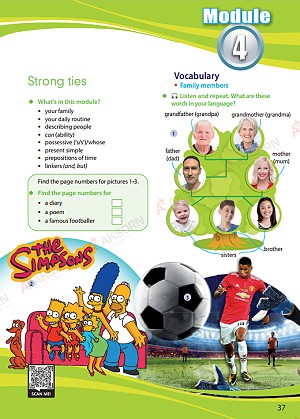Module 4 – Strong Ties

STRONG TIES
CAN DO STATEMENTS
- I can talk and write about my family
- I can describe people’s character
- I can talk about what I can and can’t do
- I can write a profile of a famous person
- I can write a text about my favourite TV family
- I can write my own poem using animal similes
GRAMMAR 11-14
In this module, you will learn about Can (ability), Possessive Case (‘s/s’/whose), Present Simple, and Prepositions of Time (at, on, in)
EXTRA: Linkers (and, but)
![]()
MODULE 4 EXERCISES แบบฝึกหัด:
- SPELLING TESTS: Flashcards | Matching 1 | Matching 2 | Spelling 1 | Spelling 2
- WORDSEARCH: One | Two
- Just a Minute
- HANGMAN
- IDIOMS – Match the Thai and English idioms
- FAMILY TREE – Sorting Names | 01A | 01B | 02A | 02B | 03A | 03B
- PHRASES: Match the English on the right to the Thai on the left
![]()
GRAMMAR EXERCISES:
![]()
Spelling List and Audio
- afternoon (n.) ตอนบ่าย
- brother (n.) พี่ชาย /น้องชาย
- busy (adj.) ยุ่ง /วุ่นวาย
- children (n.) เด็ก
- culture (n.) วัฒนธรรม
- dictionary (n.) พจนานุกรม
- evening (n.) ตอนเย็น
- fair (adj.) ผมสีอ่อน /ผิวขาว
- family (n.) ครอบครัว
- famous (adj.) มีชื่อเสียง /โด่งดัง
- father (n.) คุณพ่อ /บิดา
- football (n.) ลูกฟุตบอล /กีฬาฟุตบอล
- funny (adj.) ตลก
- gentle (adj.) อ่อนโยน
- grandfather (n.) คุณตา /ปู่
- grandmother (n.) คุณยาย /ย่า
- midnight (n.) เที่ยงคืน
- mother (n.) คุณแม่ /มารดา
- parents (n.) พ่อแม่ /ผู้ปกครอง
- people (n.) คน /มนุษย์
- playful (adj.) ขี้เล่น /ซุกซน
- routine (n.) กิจวัตรประจำวัน
- sister (n.) พี่สาว /น้องสาว
- strong (adj.) แข็งแรง
- wise (adj.) ฉลาด
![]()
ไวยากรณ์ภาษาอังกฤษ
- THE VERB CAN
– can ใช้ได้ทั้งประธานเอกพจน์และพหูพจน์ (ในรูปเดียวกันคือ can)
และรูปปฏิเสธของ can คือ cannot ไม่ใช่ can not
– เราใช้ can เพื่อ
1) แสดงถึงความสามารถ เช่น
I can speak English.
2) ขอร้องให้บางคนทำบางสิ่งบางอย่างให้ เช่น
Can I ask you a question?
3) ขอบางสิ่ง เช่น
Can you stop talking, please?
4) ขออนุญาตทำบางสิ่งบางอย่าง เช่น
Can I answer the phone?
– เราใช้ can เพื่อแสดงการห้าม / ข้อห้าม เช่น
You can’t open your books now.
- Possessive case (’s genitive) / whose
– เราใช้ possessive case เพื่อแสดงความเป็นเจ้าของ
1) สำหรับคำนามเอกพจน์และคำนามเฉพาะ เราจะเติม ’s หลังคำนาม เช่น
This is my father’s car.
2) สำหรับคำนามพหูพจน์ที่ลงท้ายด้วย -s เราจะเติมแค่ ’ เช่น
This is my cousins’ house.
3) โดยทั่วไปเราใช้ possessive case (’s) เมื่อพูดเกี่ยวกับคน แต่ถ้าพูดเกี่ยวกับสิ่งของ
เราจะใช้คำบุพบท of เช่น
Tom’s father. The legs of the table.
– เราใช้ whose เพื่อถามเกี่ยวกับความเป็นเจ้าของ เช่น
Whose diary is this? – It’s Helen’s.
- Present Simple
– ประโยค Present Simple สามารถสร้างได้โดยการใช้บุรุษสรรพนามที่ทำหน้าที่เป็นประธาน
(I / you / he / she / it / we / you / they) และคำกริยา เช่น
ประโยคบอกเล่า _ He / She / It runs.
I / You / We / They run.
ประโยคปฏิเสธ _ He / She / It doesn’t runs.
I / You / We / They don’t run.
ประโยคคำถาม _ Does he / she / it runs?
Do I / you / we / they run?
การตอบคำถามแบบสั้น _ Yes, he / she / it does.
No, he / she / it doesn’t.
Yes, I/ you / we / they do.
No, I / you / we / they don’t.
- Spelling (3rd person singular)
– คำกริยาส่วนใหญ่จะเติม -s เมื่อตามหลังสรรพนามเอกพจน์บุรุษที่ 3 (he / she / it) เช่น
I drink – He drinks, I read – He reads
– เราจะเติม -es ท้ายคำกริยาที่ลงท้ายด้วย -ss, -sh, -ch, -z, -x,-o เช่น
I kiss – He kisses, I push – He pushes, I catch – He catches, I fix – He fixes,
I go – He goes, I buzz – He buzzes, I do – He does
– คำกริยาที่ลงท้ายด้วยพยัญชนะ + y ให้ตัด -y ออก และเติม -ies เช่น
I cry – He cries, I fry – He fries
– คำกริยาที่ลงท้ายด้วยสระ + y ให้เติม -s หลัง -y ได้เลย เช่น
I say – He says, I pay – He pays
- Prepositions of time
Prepositions of time (คำบุพบทบอกเวลา) จะใช้เมื่อเราต้องการพูดว่าบางสิ่งเกิดขึ้นเมื่อไหร่
– เราใช้ at กับ
Ø เวลา เช่น at 9 o’clock, at 20:45, etc
Ø วันหยุด เช่น at the weekend, at Christmas, at Easter, etc
Ø การแสดงเวลาเฉพาะ เช่น at noon, at midday, at night, at midnight, etc
– เราใช้ in กับ
Ø ช่วงของวัน เช่น in the morning / afternoon / evening, etc
Ø เดือน เช่น in April, in November, etc
Ø ฤดูกาล เช่น in the winter / spring / summer / autumn
Ø ปี เช่น in 2000, in 1492, etc
Ø การแสดงเวลาเฉพาะ เช่น in half an hour, in 10 minutes, etc
– เราใช้ on กับ
Ø วัน เช่น on Sunday, on Friday, on weekday, etc
Ø วันที่ เช่น on 6th June, etc
![]()

